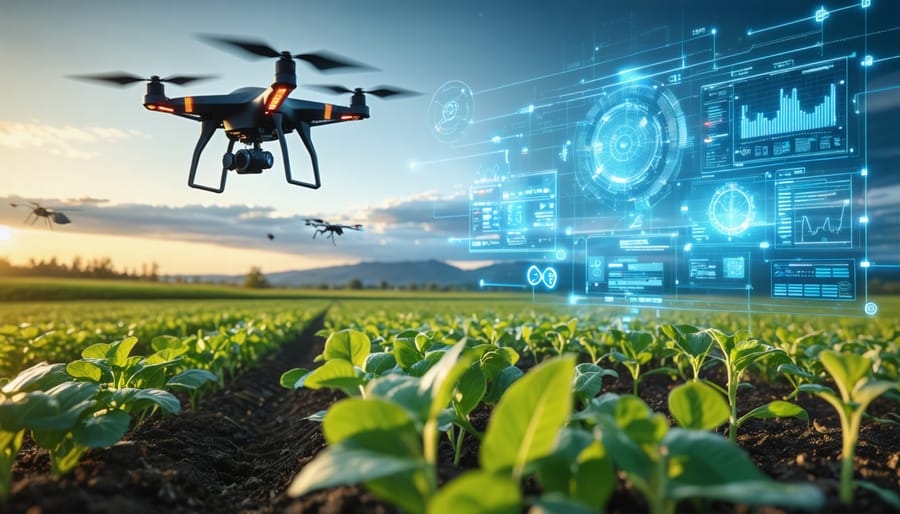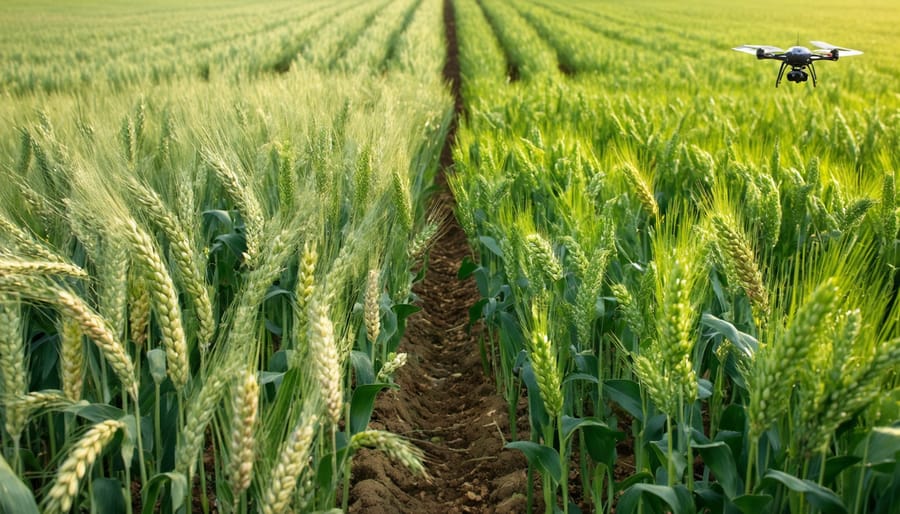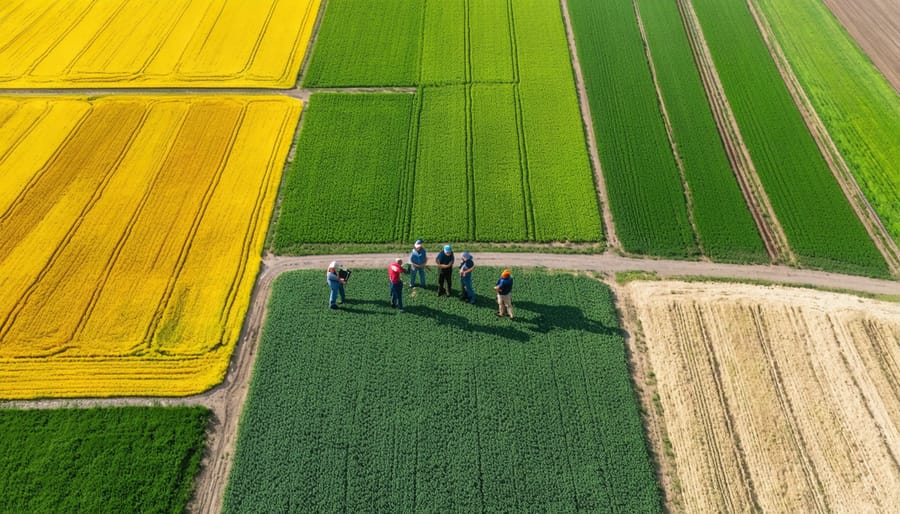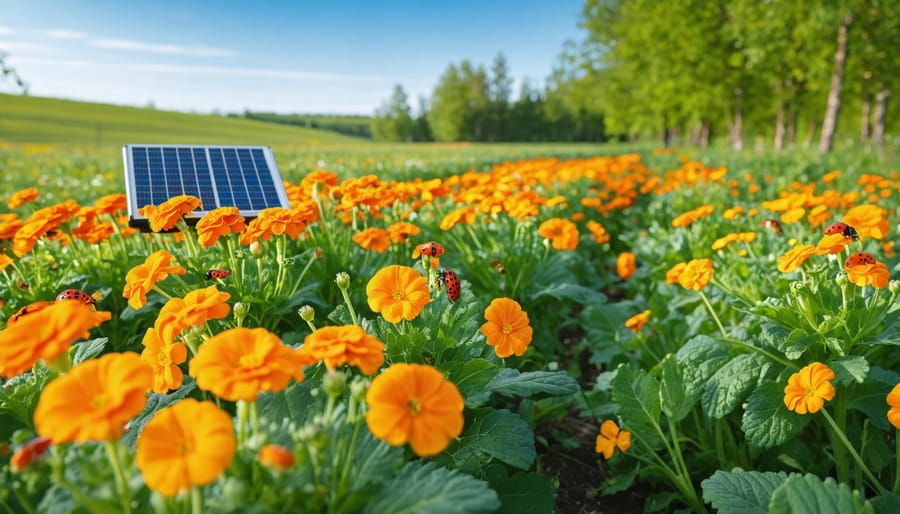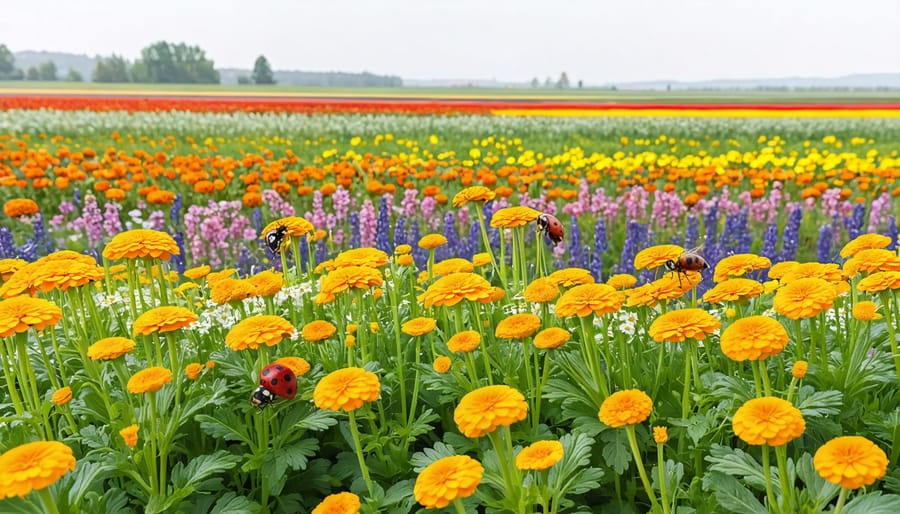Transform your pest management strategy with digital sensors that detect insect populations before they reach critical thresholds. Deploy automated monitoring systems across your fields to track pest movements 24/7, enabling precise, targeted interventions that reduce pesticide use by up to 60%. Integrate modern farming technologies like drone-mounted multispectral cameras to identify early signs of pest damage through plant stress indicators.
Canadian farmers leveraging these digital solutions have reported significant improvements in crop yields while maintaining our commitment to sustainable agriculture. Real-time data collection through IoT devices now enables precise pest forecasting, allowing producers across Alberta to make informed decisions about when and where to apply control measures.
These digital tools represent a revolutionary shift from traditional pest management methods, offering unprecedented accuracy in pest detection while supporting our environmental stewardship goals. By combining satellite imagery, ground-level sensors, and machine learning algorithms, producers can now predict and prevent pest outbreaks before they impact crop health.
The Digital Eyes in Your Fields: Modern Pest Detection Systems
Smart Traps and IoT Sensors
Smart traps and IoT sensors are revolutionizing how we monitor and manage pest populations across Alberta’s farmlands. These automated systems combine cutting-edge technology with practical farming needs, offering real-time insights into pest activities and movements.
Modern smart traps use high-resolution cameras and artificial intelligence to identify and count insects automatically. When placed strategically throughout your fields, these devices can monitor pest populations 24/7, sending instant alerts to your smartphone or tablet when pest numbers exceed predetermined thresholds.
Many Alberta farmers are now using networked monitoring systems that combine multiple sensor types. These include pheromone traps equipped with digital counters, weather stations that track environmental conditions, and soil moisture sensors that help predict pest emergence patterns. All this data feeds into a central dashboard, giving you a comprehensive view of your field’s pest situation.
For example, Dave Thompson, a grain farmer near Red Deer, installed a network of smart traps across his 2,000-hectare operation. “The system caught a grasshopper outbreak three days earlier than we would have spotted it visually,” he shares. “That early warning helped us protect about 40% more crop than we typically would.”
These systems are particularly valuable for monitoring nocturnal pests and tracking migration patterns. The collected data helps create detailed pest pressure maps, enabling more precise and timely intervention while reducing unnecessary pesticide applications.
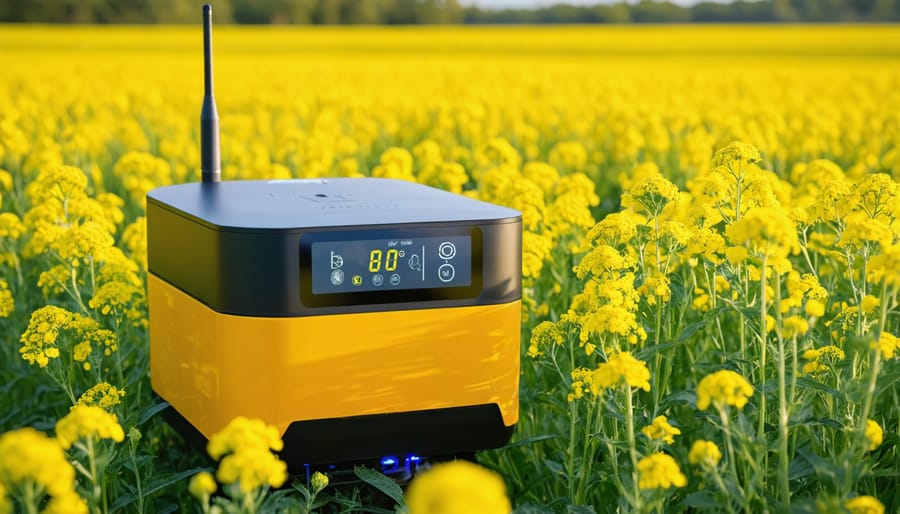
Drone and Satellite Surveillance
Modern aerial surveillance has revolutionized how we detect and monitor pest issues across Alberta’s vast agricultural landscapes. Agricultural drone technology equipped with specialized cameras and sensors can now survey hundreds of hectares in a single flight, providing farmers with detailed insights into crop health and pest infestations.
Local farmer James McKenzie from Lethbridge shares his experience: “Using drones helped us spot a grasshopper infestation in our canola field two weeks earlier than we typically would have noticed it from ground level. The early detection saved us nearly 40% on treatment costs.”
Satellite imaging complements drone surveillance by offering broader coverage and historical data tracking. Through platforms like Statistics Canada’s Earth Observation Data Portal, farmers can access regular satellite imagery to monitor crop development and identify potential pest hotspots before they become major problems.
The integration of these technologies with farm management software allows for precise mapping of problem areas and targeted treatment applications. Many Alberta producers are now using AI-powered analysis tools that can automatically detect changes in crop patterns and alert farmers to possible pest activity.
For best results, experts recommend combining weekly drone surveys with monthly satellite imagery analysis during peak growing seasons. This dual approach provides both immediate tactical information and longer-term strategic insights for pest management planning.
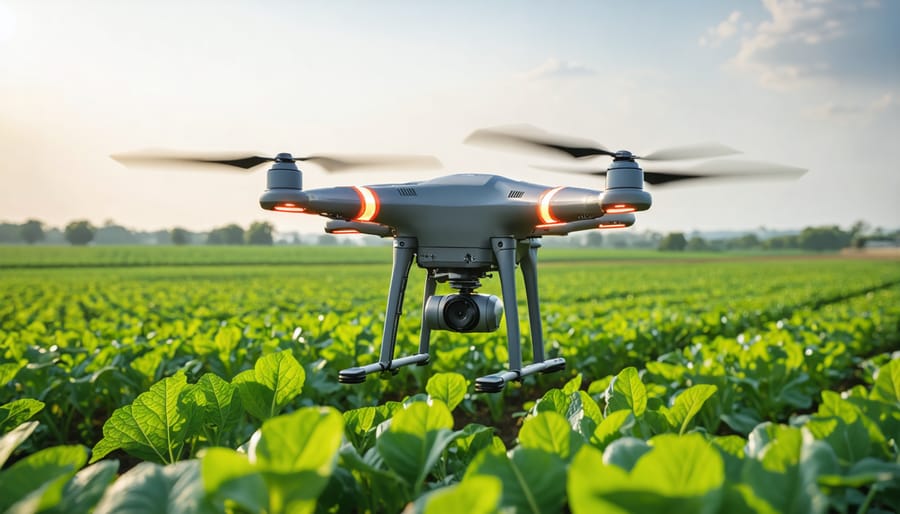
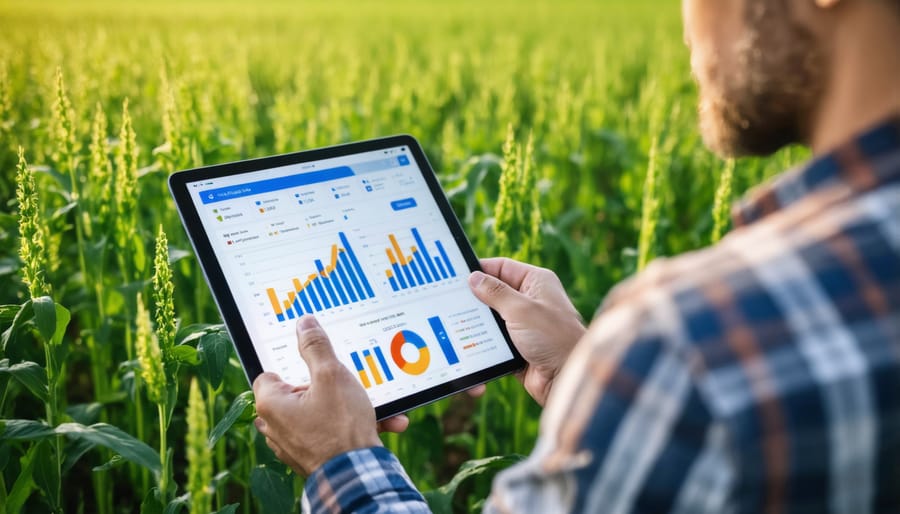
Real-Time Data Analysis: Making Sense of Pest Patterns
AI-Powered Pest Identification
Modern pest management has been revolutionized by artificial intelligence in agriculture, particularly in the crucial area of pest identification. Alberta farmers are increasingly adopting smart imaging systems that can identify harmful insects and plant diseases with remarkable accuracy, often before they become visible to the human eye.
These AI-powered systems use sophisticated cameras mounted on equipment or drones to capture high-resolution images of crops. The software analyzes these images in real-time, comparing them against vast databases of known pests and disease patterns. For example, at the McCarthy family farm near Lethbridge, their automated monitoring system successfully identified an early-stage grasshopper infestation in spring 2023, allowing for targeted intervention that saved an estimated 40% of their canola crop.
The technology doesn’t just identify pests – it tracks their populations and movement patterns over time. By collecting data throughout the growing season, these systems create detailed maps showing pest hotspots and predict potential spread patterns. This information helps farmers make informed decisions about when and where to apply control measures.
Many Alberta agricultural co-ops now offer mobile apps that connect to these AI systems, allowing farmers to receive real-time alerts and share data with neighboring farms. This collaborative approach has proven especially effective in managing region-wide pest challenges, such as bertha armyworm outbreaks, while reducing the overall use of pesticides by up to 30% through more precise application methods.
Predictive Analytics for Pest Management
Predictive analytics has revolutionized how we approach pest management in Canadian agriculture, offering farmers powerful tools to stay ahead of potential infestations. By analyzing historical data, weather patterns, and crop conditions, these systems can forecast pest pressures with remarkable accuracy.
Here in Alberta, farmers are increasingly using weather-based prediction models that combine local temperature, humidity, and precipitation data to anticipate pest development cycles. For instance, canola farmers in the Peace River region have reduced pesticide applications by 30% using these forecasting tools to time their treatments more effectively.
These systems work by monitoring key environmental triggers that influence pest behaviour. Temperature degree-days, soil moisture levels, and crop growth stages are processed through sophisticated algorithms to generate early warning alerts. When conditions become favorable for specific pests, farmers receive notifications allowing them to implement preventive measures before infestations take hold.
Local success stories include the Brown family farm near Lethbridge, which saved approximately $15,000 in the 2022 growing season by using predictive analytics to manage grasshopper populations. Their system identified optimal treatment windows based on hatching predictions, leading to more targeted and efficient control measures.
The technology also supports community-based pest management. When multiple farms in an area use these systems, they can share data and coordinate their response strategies, creating more effective regional pest control networks. This collaborative approach has proven particularly successful in managing migratory pests like diamondback moths across the prairie provinces.
Remember to combine these predictive tools with regular field scouting and local expertise for the best results. The technology should enhance, not replace, traditional pest management practices.
Implementation Success Stories: Alberta Farmers Leading the Way
Meet John Anderson, a third-generation farmer from Lethbridge County, who transformed his 2,000-hectare canola operation using smart pest monitoring systems. “Since implementing digital trap networks two years ago, we’ve reduced pesticide use by 40% while maintaining yield quality,” Anderson shares. His success stems from strategically placing IoT sensors throughout his fields, which alert him to pest presence before infestations become severe.
In the Peace River region, Sarah Mitchell’s story showcases how drone technology revolutionized her pest management approach. Using thermal imaging and AI-powered recognition software, she identifies pest hotspots across her 1,500-hectare wheat fields with unprecedented precision. “The technology pays for itself,” Mitchell explains. “We’re saving roughly $75 per hectare on pest control costs while protecting beneficial insects.”
The Cooperative Farming Initiative in Red Deer County demonstrates the power of community-based digital pest management. Ten local farms share a network of smart sensors and weather stations, creating a comprehensive pest monitoring system across 5,000 hectares. Project coordinator Mike Thompson reports, “By sharing data and resources, we’ve created an early warning system that benefits everyone. When one farmer detects an issue, we all know to be on alert.”
Near Medicine Hat, the Zhang family’s organic vegetable operation uses automated pest identification systems to maintain their certification standards. Their smartphone-based system photographs and identifies insects in real-time, helping them make informed decisions about biological control methods. “The technology helps us stay organic while competing with conventional farms,” explains Lisa Zhang.
These success stories share common elements: careful planning, willingness to learn new technologies, and support from local agricultural extension services. The Alberta Digital Agriculture Network offers training and technical support, helping farmers transition to digital pest management systems successfully.
First-year results typically show 20-30% reduction in pesticide use, with some operations achieving up to 50% savings by the third year. More importantly, these farmers report increased confidence in their pest management decisions and better work-life balance thanks to automated monitoring systems.
Getting Started with Digital Pest Monitoring
Starting your digital pest monitoring journey doesn’t have to be overwhelming. Like many Alberta farmers who’ve successfully made agricultural technology investments, you can begin with a phased approach that suits your operation’s scale and budget.
Begin by assessing your current pest management challenges and setting clear objectives. Are you dealing with specific crop threats? Looking to reduce pesticide use? Understanding your goals will help determine the most suitable digital solutions for your farm.
Most farmers start with basic components: weather stations, pest traps with digital sensors, and a user-friendly software platform to collect and analyze data. Entry-level systems typically range from $2,000 to $5,000, with additional sensors costing $200-$500 each. Many equipment suppliers offer flexible payment plans and seasonal rental options to help manage upfront costs.
Local agricultural technology providers offer comprehensive support packages, including installation, training, and ongoing technical assistance. The Alberta Agriculture and Forestry department also provides resources and workshops to help farmers transition to digital monitoring systems. Consider connecting with neighboring farms that have implemented similar solutions – many are willing to share their experiences and insights.
To ensure success, follow these practical steps:
1. Start with a pilot program in a single field or crop area
2. Document your baseline pest management costs and practices
3. Train key staff members on the new technology
4. Regularly review and analyze the collected data
5. Adjust your pest management strategy based on digital insights
Remember that support is readily available through various channels. Agricultural extension services, technology vendors, and farmer networks across Alberta can provide guidance throughout your implementation journey. Many producers find that joining local precision agriculture groups helps them stay current with best practices and troubleshooting tips.
The transition to digital pest monitoring typically shows positive results within the first growing season, with most farmers reporting improved pest detection rates and reduced chemical applications. Start small, learn from the experience, and expand your digital monitoring program as you build confidence in the technology.
Digital pest control represents a significant leap forward in Canadian agriculture, offering farmers powerful tools to protect their crops while reducing chemical inputs and environmental impact. Through the integration of smart sensors, data analytics, and automated monitoring systems, producers across Alberta and beyond are experiencing increased crop yields while maintaining sustainable farming practices.
The benefits are clear: reduced pesticide use, lower operational costs, and more precise intervention timing have made digital pest control an invaluable asset for modern farming operations. Many Alberta farmers report savings of 20-30% on pest management costs while achieving better results than traditional methods. These technologies also support our commitment to environmental stewardship by minimizing chemical applications and protecting beneficial insects.
Looking ahead, the future of digital pest control appears promising. Emerging technologies like artificial intelligence and machine learning will further enhance our ability to predict and respond to pest threats. Research at Canadian agricultural institutions suggests that upcoming innovations will include even more sophisticated monitoring systems, improved integration with farm management software, and enhanced predictive capabilities.
For our farming community, embracing these digital solutions isn’t just about staying competitive – it’s about building a more sustainable and efficient agricultural sector. As we continue to face challenges like climate change and evolving pest pressures, digital pest control will remain a crucial tool in our agricultural toolkit, helping ensure the long-term success of Canadian farms for generations to come.

